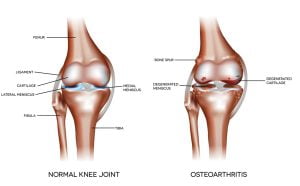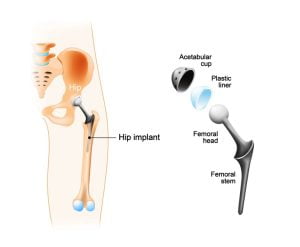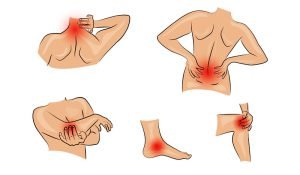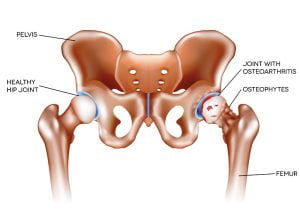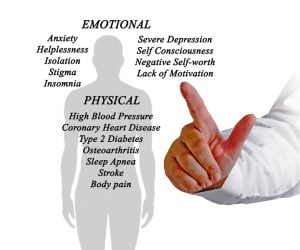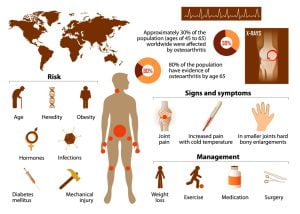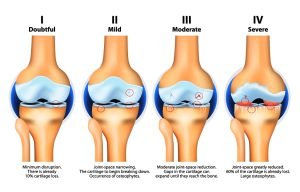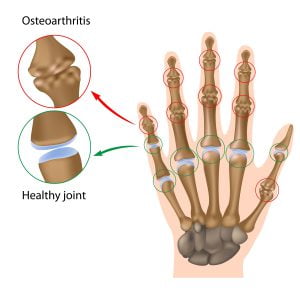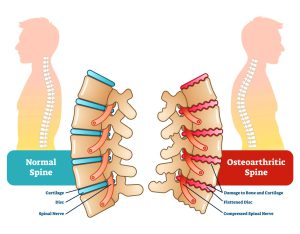Browsing: Osteoarthritis Graphics
Comprehensive Information, Resources, and Support on Osteoarthritis
There are more than 100 different forms of arthritis and related diseases/conditions. The most common types of them are osteoarthritis, rheumatoid arthritis, psoriatic arthritis, and gout. A study by Arthritis Foundation states that different types of arthritis affect more than 50 million American adults and 300,000 children. Osteoarthritis is the most common type of arthritis which results in the break-down of cartilage in a joint from aging or repetitive movements. Rheumatoid arthritis is an autoimmune disorder when the immune system itself attacks parts of the body, especially the joints.
Osteoarthritis is a degenerative disease of bones and joints and is a leading cause of knee joint space narrowing. It is the most common joint disorder.
In a total hip replacement surgery, the damaged bone and cartilage is removed and replaced with prosthetics/implants. The damaged femoral head is removed and replaced with a metal stem that is placed into the hollow center of the femur.
Arthritis is defined as inflammation of a joint. The most common cause is wearing out of the joint surface cartilage (osteoarthritis). Post-traumatic arthritis is a common form of osteoarthritis that occurs due to a physical injury to a joint. Arthritis can cause severe pain.
Hip osteoarthritis causes the cartilage that cushions your joints to be lost, resulting in pain and stiffness. Osteoarthritis of the hip can occur due to structural problems with the hip joint (hip dysplasia, femoroacetabular impingement), improper formation of the hip joint at birth, increasing age, obesity, muscle weakness, injury to the hip, stress on joints due to a sport activity, etc. Imaging tests are used for detection. Physiotherapy, medications, osteotomy, hip replacement, hip resurfacing, etc are several treatment
Obesity and osteoarthritis – The most significant impact of obesity on the musculoskeletal system is associated with osteoarthritis. Osteoarthritis pathogenesis is linked to both – excessive joint loading and altered biomechanical patterns, according to research studies. Weight plays an important role in joint stress. When people are obese, it puts stress on their weight-bearing joints, like the knees and the hip and there are chances of osteoarthritis. Excess fat tissue creates a constant state of inflammation in the body and places a mechanical load on cartilage and bone. This leads to a release of inflammatory proteins which results in joint destruction.
The infographic presents general overview of the disease including risks, causes, symptoms, treatment etc.
Osteoarthritis (OA) is divided into four stages. Stage 1 is assigned to a normal, healthy knee. The highest stage, 4, is assigned to severe osteoarthritis.
Osteoarthritis can affect any joint, including those in the hands. About half of all women and 25% of all men will experience the stiffness and pain of hand due to osteoarthritis by the time they are 85 years old. During hand arthritis, a person might feel ache in hands, joint stiffness, difficulty in finger movement, weak grip, swelling and tenderness in the knuckles or around the wrist. In some cases, cracking, bony lumps and bumps might also be felt in hands. Occupational therapy is given to improve hand dexterity, and to protect joints from further degeneration. Pain killers, cortisone shots, assisted devices, etc are also some measures during treatment of hand osteoarthritis.
Spinal osteoarthritis is the degenerative arthritis of the spine. It is also known as degenerative joint disease. It involves breakdown of the cartilage of the joints and discs in the neck and lower back. Risk factors associated with spinal osteoarthritis are advancing age, gender (female), family history of osteoarthritis, repetitive stress, defective joints or cartilage at birth, etc. X-rays and MRIs are used for diagnosis of bone spurring, narrowing of bone, pinched nerve, etc.
ADVERTISEMENT





